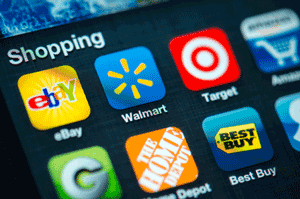 The amount of current and potential customers who own smart devices (phone or tablet) continues to increase significantly each quarter. According to eMarketer, smartphone adoption has already passed 50% in the United States and is making similar strides around the world.
The amount of current and potential customers who own smart devices (phone or tablet) continues to increase significantly each quarter. According to eMarketer, smartphone adoption has already passed 50% in the United States and is making similar strides around the world.
With a steady growth rate, mobile commerce is already generating meaningful revenue for many top retailers. For every business, mobile should now be a priority for increasing revenue and growth. The market is ready as consumers are spending more time on their mobile devices than watching television or using the desktop.
Making your business mobile accessible is a straightforward task, but actually getting customers to use your mobile app or site can be extremely difficult. In order to help, there are five key strategies that can be used to drive more purchases through mobile devices.
Optimize for Usability
Many companies developing mobile apps simply port their website content and design straight into the app and wonder why their customers don’t use it. Mobile customers need an extremely streamlined process, one that can be completed in a short five-minute bus ride.
An app must be extremely fast. On average, consumers expect your app to launch in 2 seconds or less. The slower your app runs the more likely consumers will leave without making a purchase.
Mobile apps are all about making a task easier. The fewer steps it takes to complete a purchase the better. Forms that are required for purchasing should be short and easy to fill out. Remove advertisements that clutter the screen. Lastly, utilize large buttons to make it easy to navigate.
Creating accounts that store personal information can help increase mobile purchases is a great way to simplify the ordering process. Think in terms of making purchases as simple as Amazon’s 1-Click.
Provide Exclusive Content
Providing rewards, coupons, or deals that are only available through your mobile app will repeatedly drive customers back to your app. Daily or weekly rewards establish a rhythm for customers to continually return.
Once a customer has made a single purchase through a mobile app, they are more likely to do so again, and exclusive content is an effective way to jumpstart this process.
App Marketing
It’s difficult to use an app you don’t know is available. Make it clear on your website that you have an app, what platform it is on, and direct customers to download it.
Integrate social media share buttons to allow customers to share items they have bought or want to buy with their friends. This is free marketing that works better than the majority of ad campaigns.
App Reputation
The last thing customers see before downloading your app is its rating. Negative reviews and low ratings are strong deterrents. A great product gets great reviews, but commonly only customers with negative experiences share reviews. Create a strategy to proactively ask happy customers to rate your app to overwhelm the possible few cases of dissatisfaction.
Mobile Support
Mobile support, like web support, is important for any business to ensure quality experiences and smooth out issues. Providing customer support is a new feature for many mobile apps but in a customer centric thriving world, it is important to be actionable in supporting customers even inside your app.
By providing support you also create an alternative channel for customers to vent concerns. This can often lead unhappy customers to your support experts instead of leaving a negative review in the app store.
Your business needs to take steps to being available on mobile devices. Increasing usability of your mobile site or app will have the largest effect on driving purchases through a mobile app. When discussing design and user experience remember that less is more, especially in mobile.
As your customers are becoming mobile, it won’t be long until they start clamoring for a mobile solution. Start development now and introduce these strategies into your app to make it a useful tool for customers, and a profitable one for you.
Ezra Siegel is the vice president of community with Apptentive.